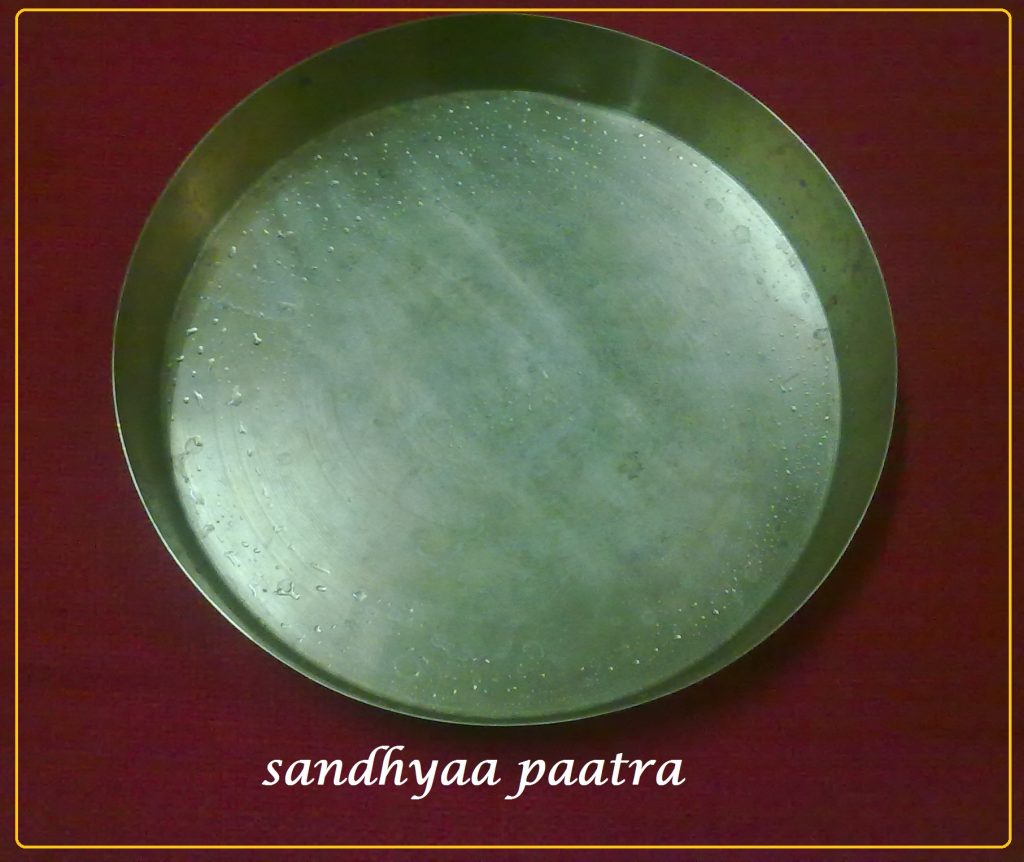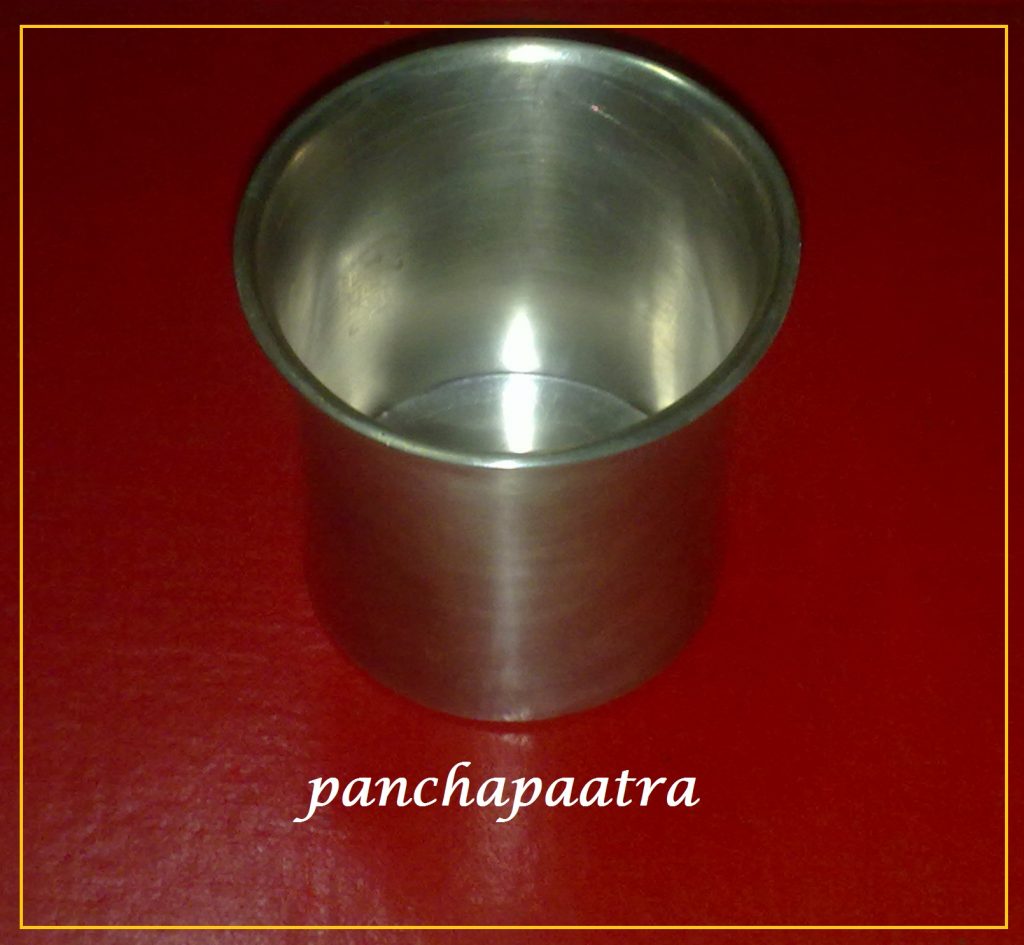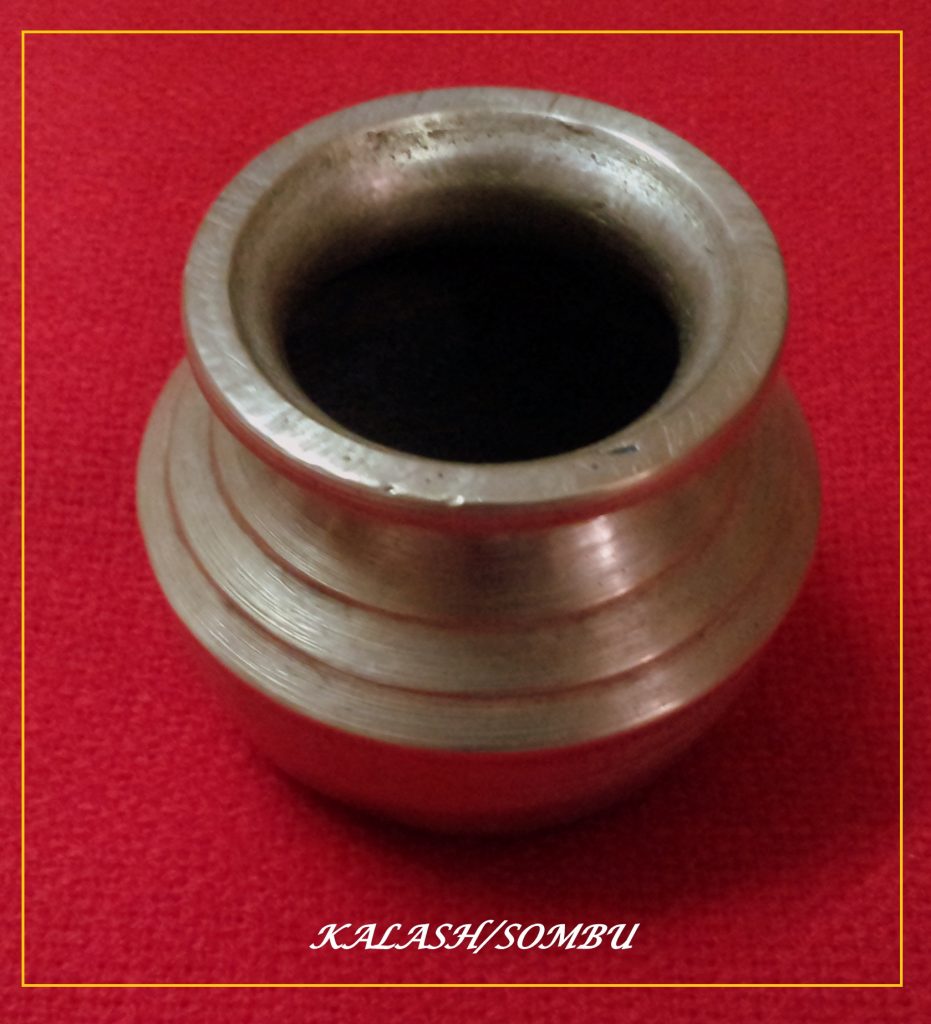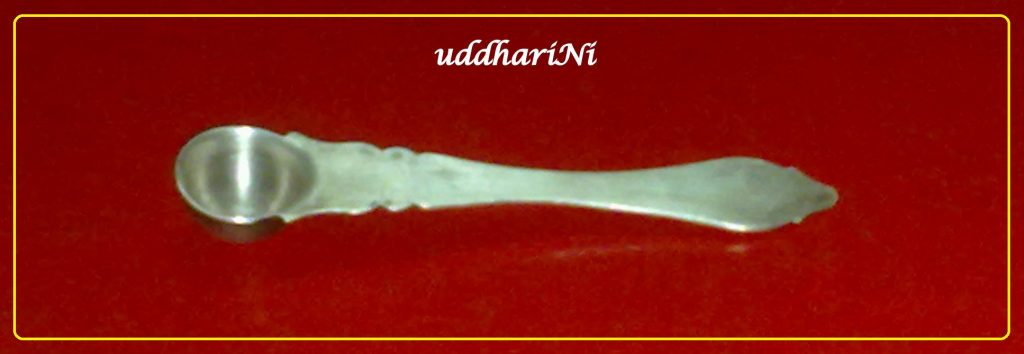sandhyAvandanam
“sandhyAvandanam” is a “nitya karmA”, a daily obligatory duty of the dwijas. (those who wear the sacred thread)
“sandhyA” means ‘twilight’ and “vandanam” means ‘worship’.
sandhyAvandanam is the worship performed at dawn and dusk to the supreme Lord who is the indweller of the disc of the sun. The meditative repetition of the gAyatri mantrA and the offerings of water called “arghyam” are central to the “sandhyAvandanam” procedure.
“vEda mAtA gAyatree”
The word “gAyatree” has its origin in the Sanskrit phrase “gAyantam trAyatE iti” which means that mantra which rescues the chanter from all adverse situations that may lead to mortality. gAyatree mantra finds its place in rig Veda samhitA 3. 62. 10. gAyatri is the mother of vEdAs. gAyatri mantrA is the most powerful mantra. She is called tripAda gAyatri having three sections of 8 syllables each. (“tatsavitu:” to “prachOdayAt”). The “taittriya AranyakA” 2.10 and 2.11 describes about the pancha maha yagya and sandhyAvandanam to be performed by a dvija. It also specifies that the praNava mantrA “Om” and the 3 mahAvyAhrutIs, “bhoo:, bhuva: and suva:” be always recited before the “gAyatri mantrA”. So the mantrA took the most powerful form as follows:
The gAyatree mantrA is initiated by a brahman priest/pandit during the “upanayana samskArA”. The mantrA is given below for reference only.
ॐ भूर्भुव॒: सुव॑: । तत्स॑वि॒तुर्वरे॓ण्यं॒ भर्गो॑ दे॒वस्य॑ धीमहि । धियो॒ यो न॑: प्रचो॒दया॓त् ॥
Om bhoor bhuvah suvah, tatsavitur varENyam, bhargO dEvasya dheemahi, dhiyO yO nah prachOdayAt.
We meditate upon the effulgence of that adorable supreme divine reality, the source of the physical, the astral and the heavenly spheres of existence. May that supreme divine being enlighten our intellect, so that we may realise the supreme truth.”
Sage Yagyavalkya says:
पूर्वा सन्ध्या तु गायत्री सावित्री मध्यमा स्मृता |
या भवॆत्पश्चिमा सन्ध्या सा विग्यॆया सरस्वती ||
“poorvA sandhyA tu gAyatree sAvitree madhyamA smrutA
yA bhavEtpashchimA sandhyA sA vigyEyA sarasvatee”
“You are called “gAyatree” at dawn, sAvitree at mid-day and “sarasvatee” at dusk ” and correspondingly we do the “prAta: sandhyA”, “mAdhyAhnikam” and “sAyam sandhyA” with salutations to the respective sandhyA dEvis.
1. In Vishnu PurANA 2.8. (49 – 52) , Sri ParAsharA expounds to Sri maitrEya muni
सन्ध्या काले च सम्प्राप्ते रौद्रे परम दारुणे |
मन्देहा राक्षसा घोरा: सूर्य मिच्छन्ति खादितुम् ||
“sandhyA kAlE cha samprAptE roudrE parama dAruNE
mandEhA rAkShasA ghOrA: soorya michChanti khAditum”
During the dreadful twilight (sandhyA – the conjunction of day and noon or noon and evening or night and day),a rAkshash gaNA called “mandEhA” comes to eat up the sun. A war begins between the two. This was due to the curse of prajApati in yonder years.
तत: सूर्यस्य तैर्युद्धं भवत्यत्यन्तदारुणम् |
ततो द्विजोत्तमास्तोयं सन्ग्शिपन्ति महामुने ||
ॐ कार ब्रह्मसंयुक्तं गायत्र्या चाभिमन्त्रितम् |
तेन दह्यन्ति ते पापा वज्रीभूतेन वारिणा ||
“tata: sooryasya tairyuddhaM bhavatyatyantadAruNam
tatO dvijOttamAstOyaM sangshipanti mahAmunE
oum kAra brahmasaMyuktaM gAyatryA chAbhimantritam
tEna dahyanti tE pApA vajrIbhootEna vAriNA
During these daily twilight wars, the chants of the “Om” mantrA followed by the gAyatri and the libations of water given by the the dvijAs are converted into “vajrA” a weapon called thunderbolt which assist“soorya” in destroying the wicked demons.
It is said that the first “arghyam”- libations of water destroys the asurA’s vAhanam (vehicle), the second arghyam destructs their weapon and the third arghyam kills the demons.
2. Manusmriti 2.102 says:
पूर्वां सन्ध्याम् जपंस्तिष्ठन् नैशम् एनो व्यपोहति |
पश्चिमाम् तु समासीनो मलम् हन्ति दिवाक्रुतम् ॥
“poorvAM sandhyAm japaMstiShThan naisham EnO vyapOhati
pashchimAm tu samAseeno malam hanti divAkrutam”
He who does the morning japa in the sandhyAvandanA removes the guilt contracted during the previous night and he who performs it in the evening with the western sun destroys the sins committed during the day.
3. Taittireeya AraNyaka 2 – 2- 1 says :
उद्यन्तमस्तम् यत्तमादित्यमभिध्यायन् कुर्वन् ब्राह्मणो विद्वान् ।
सकलम् भद्रमश्नुते सावादित्यो ब्रह्मेति ॥
“udyantamastam yattamAdityamabhidhyAyan kurvan brAhmaNo vidvAn
sakalam bhadramashnutE sAvAdityo brahmEti”
A brAhmaNa who contemplates on the rising and setting of the sun and does obeisance with gAyatree attains all bliss because this Aditya is the Supreme Brahman.
4. Yaju: sarvAnukrama sootram 1.1 says:
‘अथ विज्ञायैतानि यॊ अधीतॆ तस्य वीर्य वदथ, यॊ अर्थवित्तस्य वीर्यवत्तरं भवति, जपित्वा हुत्वॆष्ट्वा तत्फलॆन युज्यतॆ’
‘atha vij~jAyaitAni yO adheetE tasya veerya vadatha, yO arthavittasya veeryavattaraM bhavati,
japitvA hutvEShTvA tatphalEna yujyatE’
One who recites the sandhyA mantras after knowing the Rishi, chandas, dEvatA,etc, will become strong.
One who recites the sandhyA mantras after knowing its meanings, will become more powerful.
ONe who meditates on the mantras and performs hOmam with the mantras will reap the benefits of the mantras.
1. Those who have been initiated with the “gAyatri mantrA” at the time of “upanayanA” can start doing “sandhyAvandanam”.
2. After “upanayana”, the dvijA is entitled to perform certain duties amongst which sandhyAvandanam is foremost and mandatory. BrAhmaNAs, kshatriyAs and vaishyAs are called dvijAs.
SandhyAvandanam should be performed three times a day.
1. vishvAmitra smRuti 1.22-24, sandhyAtritayalakshaNam says:
प्रात: सन्ध्या
Morning sandhyA prayers
उत्तमा तारकोपेता मध्यमा लुप्ततारका । अधमा सूर्य सहिता प्रातस्सन्ध्या त्रिधा मता ॥
uttamA tArakopetA madhyamA luptatArakA adhamA soorya sahitA prAtassandhyA tridhA matA.
The best time to start the sandhyA prayers is before sunrise when the stars are still visible , next in preference is when the stars become invisible, and the sandhyAvandanam started when the sun is visible is not at all preferred. These are the 3 advices on prAta: sandhyA.
माध्याह्निक सन्ध्या
mAdhyAhnika sandhyA prayers
उत्तमा पूर्वसूर्या च मध्यमा मध्यसूर्यका ।
अधमा पश्चिमादित्या मध्यसन्ध्या त्रिधा मता ॥
uttamA poorvasooryA cha madhyamA madhyasooryakA adhamA pashchimAdityA madhyasandhyA tridhA matA
The best time to start afternoon sandhyAvandanam is when the sun begins to move right above our head, the next in preference is when the sun shifts slightly towards the west, and the sandhyA performed when the sun is at the west is not at all preferred. These are the 3 advices on madhya sandhyA.
सायम् सन्ध्या
sAyam sandhyA
उत्तमा सूर्यसहिता मध्यमा लुप्तभास्करा ।
अधमा तारकोपेता सायंसन्ध्या त्रिधा मता ॥
The best time to start evening sandhyAvandanam is when the sun is visible and about to set, the next in preference is when the sun has already set and the sandhyA performed after the stars have become visible is not at all preferred. These are the 3 advices on sAyam sandhyA.
It is to be noted that prAtah sandhyA should start before sunrise and the japa should continue till the orb (disc) of the sun is seen. mAdhyAhnikam should start somewhere around 11.30 a.m. to 12.00 a.m. This is the time when the sun is not very hot. The time for sAyam sandhyA starts at the time when sun’s disc is about to set and the japa should continue till the rise of the stars.
Manusmriti 2.101 says
पूर्वां सन्ध्याम् जपांस्तिष्ठेत् सावित्रीम् आ-अर्कदर्शनात् ।
पश्चिमाम् तु समासीन: सम्यग् ऋक्षविभावनात् ॥
“poorvAM sandhyAm japAnstiShThEt sAvitreem A-arkadarshanAt pashchimAm tu samAseenaha samyag RukShavibhAvanAt” Let him stand during the morning twilight muttering sAvitree until the sun appears but let him sit with the evening- western sun reciting it until he can see the stars.
Manusmriti 4.94 says
ऋषयो दीर्घसन्ध्यत्वात् दीर्घमायुरवाप्नुयुः ।
प्रज्ञाम् यशश्च कीर्तिम् च ब्रह्मवर्चसमेव च ॥
“riShayO deerghasandhyatvAt deerghamAyuravApnuyuhu pragyAm yashashcha keertim cha brahmavarchasamEva cha”
Ancient seers attained long life, fame, intelligence and spiritual eminence by long SandhyA prayers. That is why more time should be devoted for sandhyA prayers.
1. It can be performed in the house, on a clean floor or in the courtyard preferably where the sun is visible at dawn and dusk. Otherwise at the altar of the house.
गृहे त्वेकगुणासन्ध्या गोष्ठे दशगुणास्मृता ।
शतसाहस्रिका नद्याम् अनन्ताविष्णु सन्निधौ ॥
“gruhE tvEkaguNAsandhyA gOSHTHE dashaguNAsmrutA
shatasAhasrikA nadyAm anantAviSHNu sannidhou.
If the sandhyAvana performed at home bestows one unit of merit, then the sandhyavandanam performed in a cowshed will give 10 times the merit (gOShThe dashagunAsmrutA), and the one performed at the river gives more than 1000 times the merit (shata sAhasrikA nadyAm) , and countless merits shall accrue if performed at Vishnu Sannidhi/or in temple ( anantAvishnu sannidhow).
sandhyAvandanam or sandhyOpasanA procedures should be learnt from your guru/pandit officially at the time of “upanayanA”, the initiation ceremony of the sacred thread because they contain mantrAs from the VedAs and have swarAs. Thereafter, it can be practised with the help of your elders or through other medias.
Please click on“My sandhyAvandanam” icon to get your personalised complete procedure.
In the morning we do “PrAtah sandhyAvandanam” or “PrAtah sandhyOpAsanA”
In the afternoon we do “MAdhyAhnikam”
In the evening we do “SAyam sandhyAvandanam” or “SAyam sandhyOpAsanA”
The traditional sandhyAvandanam procedure has 2 parts.
1) poorva bhAgam and 2) uttara bhAgam
1) poorva bhAgam has those basic purificatory karmAs like Achamanam, angavandanam, praNAyAmam, sankalpam, prOkshaNam, prAshanam, punar mArjanam, arghya pradhAnam, Atma anusandhAnam, Navagraha/keshavAdi tarpaNam.
2) uttara bhAgam has the main gAyatri japa sankalpa, gAyatri AvAhanam, gAyatri japa nyAsam, gAyatri dhyAnam, gAyatri japa, upasthAnam, digdEvatA vandanam, dig vandanam, soorya nArAyaNa vandanam, kshamA prArthanA and abhivAdanam.
Some sections of the sandhyAvandanam mantrAs differ according to castes and sub-castes..Kindly register your membership and update your caste details in the profile and then click on
“My sandhyAvandanam”
to get your complete sandhyAvandanam procedure.
THINGS REQUIRED
A kalash pot or a sombu can be used instead of a panchapAtra to hold water.
———————————————————–
Soorya darshan : Viewing the sun using vyoma mudraa.
The sun god is viewed during “MadhyAhnikam” at noon using the “vyOma MudrA” as prescribed by our seers. It is well known that the sun’s rays are harmful if viewed directly. With a little practice you should be able to use this mudrA effectively to view the sun and its circumference safely.
Follow the steps given below to form a hole between your fingers and view the sun through the hole while uttering the mantra:
Follow the steps. Step 4 is the vyOma mudrA. Bring the ring finger and middle finger of your right hand above the left thumb. Bring the ring finger and middle finger of your left hand below the right thumb. You will see a hole in the centre. Look up and view the sun through the hole.
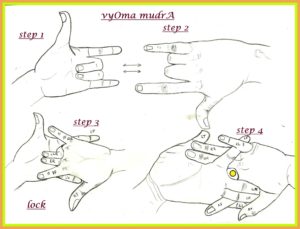
“pashyEma sharadah shatam, jeevEma sharadah shatam, nandaama sharadah shatam, mOdAma sharadah shatam, bhavaama sharadah shatam, shriNuyaama sharadah shatam, Prabravaama sharadah sharam, ajeetaassyaama sharadah shatam jyOkcha sooryam drishE”
The meaning of the mantra is “—“By his grace, looking at the sun may we pay obeisance for hundred (autumns) long years, May we live for hundred years, May we live with kith and kin for hundred long years, May we live in happiness for hundred years, May we live with name and fame for hundred years, Let us hear only good things for hundred years, Let us talk good things for hundred years, May we live unconquered for hundred years.- likewise looking at the sun let us live a life like this” (Yajur vEdA 36.24) .
- “vyOman” in Sanskrit means the sky or a temple sacred to the sun.
2.Bhavishya PurAnA says that “vyOma” is the space in the spiritual sky where the surya bhagvaan resides. This abode of the Sun god, which is far far away from the earth lies amidst 4 luminory towers called ShringAs ; 1. ‘SoumanasA’ made of Gold, 2. ‘JyotishkA’ made of ‘Padmaraaga’, 3. ‘Chitra’ made of ‘SarvadhAtu’ (All-metal) and 4. ‘Chandroujask’ made of Silver. Surya Deva rises from the “Soumanasa Shringa” at uttarAyana (summer solstice) and sets at dakshiNAyana (winter solstice) at Jyotishka Shringa. The place in between the two ShringAs is known as Vyoma where Surya Deva resides bestowing unending effulgence to protect and preserve the humanity.
1. If one is not able to perform sandhyAvandanam at the right time, he can chant the prAyashchitta mantra – “kAlAteeta prAyashchittArtha arghya pradAnam kariSHyE” and perform the sandhyAvandanam. This is only an exception and not a convenient rule.
2. A person can do mAdhyAhnikA in the morning after prAtah sandhyA in case he finds no time in the afternoon.
3. Even if a person is impure owing to mourning or of a birth in a family, he must perform sandhyAvandanam till “arghyapradAna” and must tell the mantras in the mind and not aloud.
4. Even if a person is very ill, he must at least do the gAyatree japam.
Meditation or “dhyAnA” is the key healing word today. We need not run hither and thither for this. There is an inborn healer inside us and that is our prAnA (life force). “sandhyAvandanam” encompasses the techniques of yogA and meditation. The prAnA, body and the mind are directed in a disciplined manner with the all powerful gAyatri mantras in a comprehensive manner. It is a divine way of connecting with our self everyday.
Simple meanings for sandhyAvandana mantras.
- Achamanam:
ॐ अच्युताय नम: Om achyutAya nama:
ॐ अनन्ताय नम: Om anantAya nama:
ॐ गॊविन्दाय नम: Om gOvindAya nama:
angavandanam:
ॐ कॆशवाय नम: Om kEshavAya nama: (touch right cheek with right thumb)
ॐ नारायणाय नम: Om nArAyaNAya nama: (left cheek with right thumb)
ॐ माधवाय नम: Om mAdhavAya nama: (right eye with right ring finger)
ॐ गॊविन्दाय नम: Om gOvindAya nama: (left eye with right ring finger)
ॐ विष्णवॆ नम: Om viSHNavE nama: (right nostril with right index finger)
ॐ मधुसूदनाय नम: Om madhusoodanAya nama: (left nostril with right index finger)
ॐ त्रिविक्रमाय नम: Om trivikramAyanama: (right ear with right little finger)
ॐ वामनाय नम: Om vAmanAya nama: (touch left ear with right little finger)
ॐ श्रीधराय नम: Om shreedharAya nama: (right shoulder with right middle finger)
ॐ हृषीकॆशाय नम: Om hRuSheekEshAya nama:(shoulder with right middle finger)
ॐ पद्मनाभाय नम: Om padmanAbhAya nama: (navel with right four fingers)
ॐ दामॊदराय नम: Om dAmOdarAya nama: (centre of the head with all five fingers)
This is a purificatory mantra that cleanses one of physical and mental impurities and diseases. I propitiate achyuta, ananta, govindA, etc.
2. PrANAyamam:
ॐ भू: ॐ भुव: ऒगुम् सुव: ॐ मह: ॐ जन: ॐ तप: ऒगुम्सत्यम्.
ॐ तत् स॑वि॒तुर्वरे॓ण्यं॒ भर्गो॑ दे॒वस्य॑ धीमहि धियो॒ यो न:॑ प्रचो॒दया॓त् ।
ॐ आपो॒ ज्योती॒रसो॒ ऽमृत॒ं ब्रह्म॒ भूर्भुव॒स्सुव॒रोम्
Om bhoo: bhuva: Ogum suva: Om maha: Om jana: Om tapa: Ogum satyam
Om tat saviturvarENyam bhargO dEvasya dEvasya dheemahi dhiyO yO na: prachOdayAt.
Om ApO jyOtirasO amrutam brahma bhoorbhuvassuvarOm
- First prANAyAma mantra consists of salutations to the myriad of God’s creations: – All these seven lokas (7 vyAhRutis) namely the bhoolOka, bhuvarlOka, suvarlOka, maharlOka, janalOka, tapOlOka and satyalOka are the manifestations of the BrahmaN denoted by the praNava “Om”.
- Second mantra is gAyatri mantra: – We meditate on the resplendent Lord with a transcendental form who is divine and resides inside the sun and directs our mind and intellect towards Him.
- Third prANAyama mantra is called gAyatree shiras mantra which is a re-iteration of the first mantra. This denotes the Supreme Lord denoted by praNava Om is the indweller and controller of water (Apah), fire (jyOti), taste (rasa), nectar (amRutam), BrahmA, Bhooh, Bhuvah and suvah.
Sage YAgyavalkya says that he who controls the breath and contemplates on the seven vyAhrutis, salutes all the worlds and acquires the strength to move around all these worlds. Uttering the gAyatri shiras mantra relieves one from bonds of samsAra. Breath control increases the longevity of the practicant.
3. Sankalpam
This is positive statement declaring the astrological time and historical place in which the karma is being performed.
Mama upAtta samasta duritakshayadvArA Shree ParamEshvara Preetyartham :- I perfom these rituals as I invoke ParamEshwara’s grace to destruct all my accumulated sins.
Shree bhagavat AgyayA bhagavatkainkarya roopam: – I perform these rituals as a decree of BhagavAn and as a service to Him.
Shree bhagavat AgyayA shreeman nArAyaNa preetyartham:- I perform these rituals as a decree of BhagavAn and for His pleasure.


